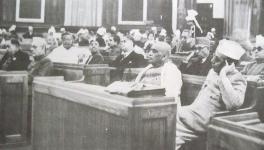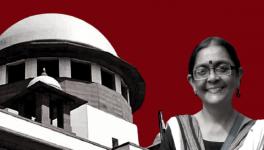A Cautionary Tale of Two Judgements: From Begumpura to Ayodhya
Assessing the constitutionality of the 2019 Supreme Court order that directed the demolition of the Guru Ravidas temple in Delhi, ANUKA BACHAWAT compares it with the Supreme Court’s landmark judgment in the Ayodhya case delivered less than three weeks later, and highlights the systemic caste discrimination that persists despite Guru Ravidas’s egalitarian ideals for urban spaces.
“WHERE all live ever free in the City of God”– Ravidas
Ravidas’s poem ‘Begumpura’ conceives of a utopian city. It imagines the harmonious co-existence of religion with the freedom and equality of all citizens. In alluding to all citizens, Ravidas, as a voice of Dalit cobblers, places caste within the city and religion — two spaces that attempt to deny the existence of caste discrimination. The poem finds no mention of kings, courts and temples.
Yet this philosophical framework allows unanswered questions about caste in religion and property rights to emerge from the legal, secular language of the Ravidas temple title dispute.
The dispute
The Ravidas temple (located in Tughlaqabad, Delhi) was demolished by the Delhi Development Authority [DDA] on August 10, 2019, as authorized by the Supreme Court. The demolition was a culmination of a 33 year-long title dispute between the Guru Ravidas Jayanti Samaroh Samiti and the DDA. In its ownership claim, the Samiti pleaded that the land was originally occupied by a member of the Samiti 160 years ago when he dug a pond in an area called ‘chamar wala johar’. Having acquired community and religious significance, a temple was inaugurated on the disputed land in 1959. Revenue records showed the Samiti’s possession of the land from 1959 till 2019. The Samiti claimed that the plot was formally transferred to the Union Government under the Delhi Law Reforms Act only as a book entry. However, the DDA alleged that the plot was encroached upon by the Samiti, although acquired by the government under the Land Acquisition Act, 1894 in 1962.
The similarity of outcomes and temporal proximity speaks to a judicial disposition towards the property rights of religious groups. One judgement justifies the demolition of a temple and the other a mosque. However, this proverbial border is dissolved because both decisions allow courts to deprive minority groups of common property without providing strong legal justification.
Also read: Erosion of Constitutional Rights and Growing Anti-caste Movements
When demolition was ordered in 2019, Dalit Ravidasi groups across Delhi, Punjab, Haryana, Rajasthan and Uttar Pradesh protested against the decision, and the demonstrations were backed by the Bhim Army and the Akhil Bharatiya Sant Shiromani Guru Ravidas Mandir Sanyukta Sanrakhshan Samiti. This deep and widespread discontentment is seen by critics as anti-environment, anti-development and a product of political propaganda. Justice Arun Mishra, who was on the Supreme Court bench deciding this dispute, said, “We are not concerned about politics and political considerations. We pass our orders based on facts and law”.
But was the Ravidas temple dispute decided on the basis of fact and law? The veracity of Justice Mishra’s proclamation in Guru Ravidas Jainti Samaroh vs. Union of India will be attempted to be examined through an analysis of the interpretation of Land Acquisition Act 1894, rather the Right to Fair Compensation and Transparency in Land Acquisition, Rehabilitation and Resettlement Act, 2013 [LARR Act] (which applies retrospectively to this case as the Land Acquisition Act was repealed and replaced by the LARR Act in 2013). The backlash against the Supreme Court decision will also be attempted to be understood as an assertion of religious identity by caste minorities rather than a product of electoral politics or anti-development sentiments.
The inconsistencies in the court’s reasoning indicates that proving government ownership was central to the judgement. The Samiti’s relationship with and possession of a space of cultural and religious significance did not occupy equal space within the legal reasoning. This disparity reveals the sinister manifestation of caste politics in property law jurisprudence.
The Guru Ravidas and Ayodhya verdicts were delivered by the Supreme Court nineteen days apart. The historical Ayodhya verdict was a landmark constitutional bench decision that determined the title of a plot claimed by Hindu and Muslim religious groups, each claiming the site as sacred land and essential to their religion. The decision was delivered in favour of the Hindu parties to the title suit. Its outcome, like the one is Guru Ravidas, was the displacement of the space of worship of a religious minority, that being the Sunni Wakf Board.
Also read: All that you need to know about Ayodhya land dispute case
The similarity of outcomes and temporal proximity speaks to a judicial disposition towards the property rights of religious groups. One judgement justifies the demolition of a temple and the other a mosque. However, this proverbial border is dissolved because both decisions allow courts to deprive minority groups of common property without providing strong legal justification. The Supreme Court seems to impose arbitrary limits on Dalit and Muslim communities’ right to property for religious use. These successive decisions thus highlight the troubling underpinnings of land acquisition laws in India.
Arbitrary limits
When the Guru Ravidas decisions are re-read alongside the LARR Act, it is seen that the Delhi High Court and Supreme Court have failed to apply the law to the facts of the title dispute. The judiciary has failed to check whether the following criteria of the LARR Act have been complied with by the DDA:
1. Purpose of acquisition by DDA unclear:Neither the Delhi High Court nor the Supreme Court enquired about the purpose of land acquisition by the DDA. The DDA had pursued the acquisition of the disputed land for 33 years, although structures existed on it and the plot was in use for religious purposes given the presence of the temple. The court did not probe the DDA’s pressing need to acquire that specific plot and how the acquisition would be used for public benefit in accordance with Delhi’s master plan. As a result of this oversight, there is no indication of whether the disputed land was to be acquired for a public purpose, a public-private partnership projects or by private companies for public purposes.
Both judicial decisions do not adequately address Section 2(2) of the LARR Act which specifies consent requirements based on the purpose of acquisition. The purpose of land use decides whether the consent of affected persons for its acquisition is required. For instance, government projects do not require owners’ consent, while the consent of 80 per cent of the land owners is required for private projects. Since the purpose of use is unclear and unacknowledged by both the Delhi High Court and the Supreme Court, the allied question of whether the Samiti’s consent was required when the DDA acquired the land remains unaddressed.
This leads to land acquisition jurisprudence that places nebulous environmental law concerns over the concrete property, cultural and religious rights of a minority community.
Circumventing the issue of the Samiti’s consent also places both decisions at odds with the object of the LARR Act, which is to “transform the process of acquisition into a humane, transparent, informed and participatory one”. Since the purpose of DDA acquisition is unclear, the temple demolition and relocation order is not grounded in legal reasoning, and is therefore a rash, unstudied act of displacement.
Further, neither judgement looks into the use and preservation of green land (or protected forest area) by the DDA. The Supreme Court order claims to protect green land through the temple demolition. The order claims to maintain the site sustainably “in pristine form, free of pollution and consistent with environmental safeguards”. However, the claim can be called into question given the court’s failure to elaborate on the sustainable measures to be taken by the DDA, and its failure to assess the environmental impact of demolition, relocation and reconstruction ordered near the green land. This then leads to land acquisition jurisprudence that places nebulous environmental law concerns over the concrete property, cultural and religious rights of a minority community.
2. Failure by courts to check or order a social impact assessment [SIA]:SIA is prescribed by LARR Act under its Sections 4, 5 and 6. Itincludes consultation with the local municipality, a public hearing, the publication of a study and an appraisal by an expert committee to assess whether the benefits of land acquisition for public purposes outweighs its costs. A petition filed before the Supreme Court last year by former Indian National Congress Parliamentarians Ashok Tanwar and Pradeep Jain Aditya highlights that the Guru Ravidas shrine is protected by the Places of Worship (Special Provisions) Act, 1991 and the adjoining structures had existed even before the formulation of Delhi’s master plan. Irrespective of the veracity of these particular claims, the judiciary overlooking the historical significance of the site is conspicuous, especially since the Supreme Court order claimed to take “note of the intense religious faith of the devotees in the site” in ordering the demolition.
The constitution of a committee was the only part of the SIA ordered by the Supreme Court in 2019 after the demolition of the temple and the decision of its relocation. This ensured that that the Dalit community could only oversee the smooth relocation and kept the Samiti out of the decision-making process entirely, having skipped the initial steps of the SIA.
The two points highlight a pattern of arbitrary oversight of crucial provisions of the LARR Act by the court. The court’s methodology is symptomatic of an entrenched structural bias and betrays hints of judicial deference to the State as well as to the prevailing hegemony. These tendencies in the Ravidas order ushered in the Ayodhya judgement where they were amplified.
Also read: Ayodhya Verdict: Historical, Legal, Social and Moral Implications
Troubling underpinnings: land acquisition contorts secularism
Contrary to Justice Mishra’s assertion, the Ravidas order is barely grounded in fact or law. The court does not engage adequately with the facts of acquisition or its purpose, nor does it enable the correct implementation of the SIA procedure. Even in its commitment to secularism, the judiciary fails to consider the historical value of this site, which pushes us to ask whether its conception of history excludes Dalits. There are no references to caste or any positioning of the Ravidasi sect within Hinduism. Invisibilising the shrine’s Dalit origins allows the court to circumvent the power differential and the need to allow the preservation of a minority religious institution.
Even in its commitment to secularism, the judiciary fails to consider the historical value of this site, which pushes us to ask whether its conception of history excludes Dalits. There are no references to caste or any positioning of the Ravidasi sect within Hinduism. Invisibilising the shrine’s Dalit origins allows the court to circumvent the power differential and the need to allow the preservation of a minority religious institution.
Law professor Amit Bindal notes, that in the Ayodhya case, “the Court does not want to confront the atrocious event of the mosque demolition”. No blood was spilled in demolition of the Ravidas Temple. However, the Court’s reluctance to confront the atrocious event of demolition remains. The atrocity here is more insidious.
Also read: A Crisis of Resistance: Aftermath of the Ayodhya Judgement
The Ayodhya decision came less than a month after the Ravidas decision. At first-glance the seemingly secular Supreme Court demolishes a mosque and a temple in the same breath. However, once this veil of Hinduism is cast aside and the Dalit origins of the temple burst forth, the Supreme Court’s approach to the common property rights of religious minorities becomes atrociously clear. The two judgements encapsulate a threat to the hope of egalitarianism that Ravidas visualizes for a literal and proverbial cityscape. Is the Supreme Court aiding the State in dismantling religious and caste diversity one monumental decision at a time? Do such judicial outcomes have the potential to conflate secularism with Hindu majoritarianism?
(Anuka Bachawat is a student of law at the Jindal Global Law School, O.P. Jindal Global (Institution of Eminence Deemed to be University), and a graduate in Literature from Ashoka University. The views expressed are personal.)
Get the latest reports & analysis with people's perspective on Protests, movements & deep analytical videos, discussions of the current affairs in your Telegram app. Subscribe to NewsClick's Telegram channel & get Real-Time updates on stories, as they get published on our website.
























